After surviving the Johnson Valley Thanksgiving run and Axle Alley right after that, I decided .the Currie steering system that was sitting in my garage would do better if mounted on the TJ rather than sitting next to it. I got Scott and Les to agree to a Saturday morning wrench session at my place. I had fresh coffee ready when Les showed up with a box of Krispy Kreme donuts. Now THAT guy knows how to come prepared to the wrenching’ party! Scott showed up a few minutes later and we were officially underway (he had the tie rod end puller).
The morning’s work was to be pretty straight forward. First, remove the old draglink and tie rod. I was running the factory draglink and had done the ZJ tie rod conversion some time back. Second, install the new Currie hardware. Third, align the toe-in. Last but not least, have some pizza and sodas for lunch. Simple enough (especially that last one).
We loosened the lug nuts and blocked up the front axle just enough to get the tires off the ground. I put a set of jack stands under the frame for safety….in case the axle slipped off of the wooden blocks or the floor jack let go (never trust either one of these as your only supporting method). There was about a half inch of space between the frame and jack stands since we wanted the full weight of the vehicle on the front suspension components when the toe-in would be set. The tires were then removed and we were ready to remove the existing hardware.
We pulled the three cotter pins from the castle nuts at the pitman arm rod end and the two steering knuckles. A tip that Scott passed on to me….do not completely remove the castle nut from the threads. When the rod end finally lets go (from the tapered hole), it won’t go flying. Lots of energy gets stored up when you are taking a rod end apart and this keeps things a bit safer.
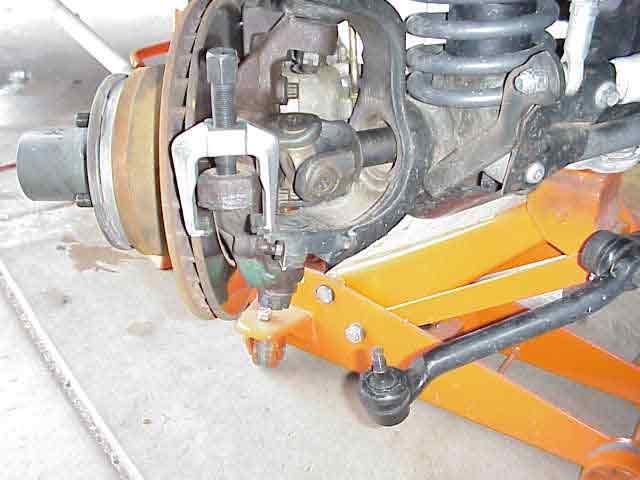
With Scott’s $6 Harbor Freight puller in hand, we popped the passenger side rod end off. One down, two to go. Scott warned me that pulling the rod end off of the end of the pitman arm would be more difficult since you have a rather tight area to work in.
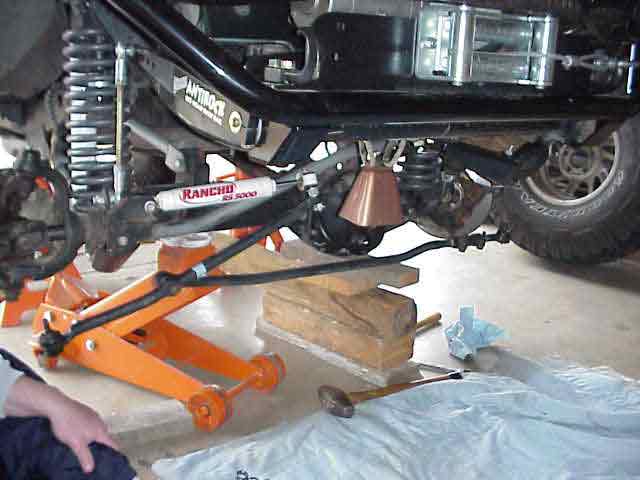
We pulled the driver’s side rod end next. The RS-5000 steering stabilizer (drag link end only) was removed from the drag link. Finally the rod end at the pitman arm was removed. Thanks to Scott for figuring out how to squeeze the rod end puller up into place by the pitman arm (there isn’t much room to navigate up there and we didn’t want to pull the pitman arm itself).
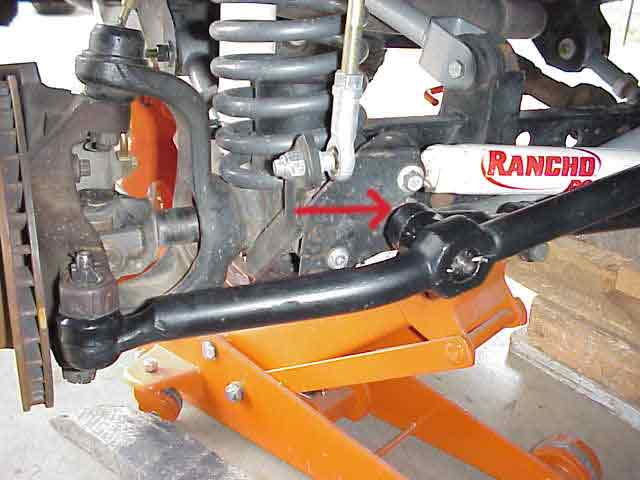
There is one known issue with the Currie steering system and that is the grease fitting that is located at the point where the drag link and tie rod join. I marked this spot in the above picture with a red arrow. The grease fitting can be broken off when a high flex situation occurs and the wheels are cranked over to full lock. This does not happen to everyone and from what can be determined, it has a lot to do with the type of suspension you have (long or short arm, adjustable control arms, how close to stock wheel base you have, etc.)
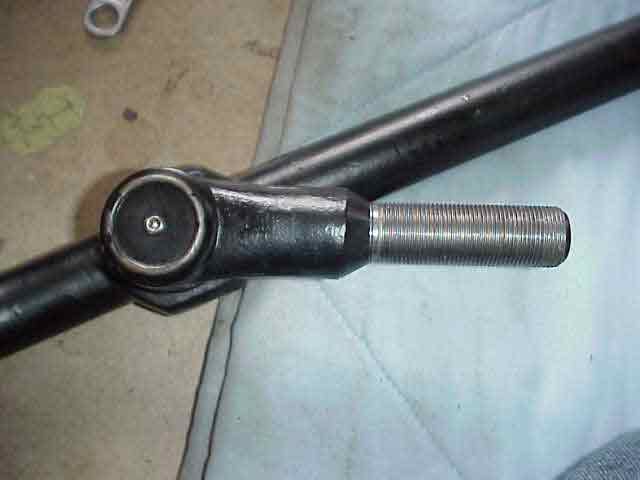
Here is the same point (the red arrow above) but shown from the back side. I removed the grease fitting and installed a flush fitting hex plug (after properly greasing the rod end) that my buddy, MikeW, sent me several weeks ago. Once he found out that I was getting the Currie steering, he knew I would be looking for one of these (he put his steering on a number of months ago and had already worked through this issue on his). I will still be able to grease the rod end when I do regular maintenance. I’ll just turn the wheels over towards the left (where there is enough clearance), removed the plug and temporarily screw in a grease fitting for the grease gun. You can obtain this “set screw” at a Lowes hardware store. It is 1/4″-28 (28 threads per inch) and uses an Allen wrench (hex plug) to install it.
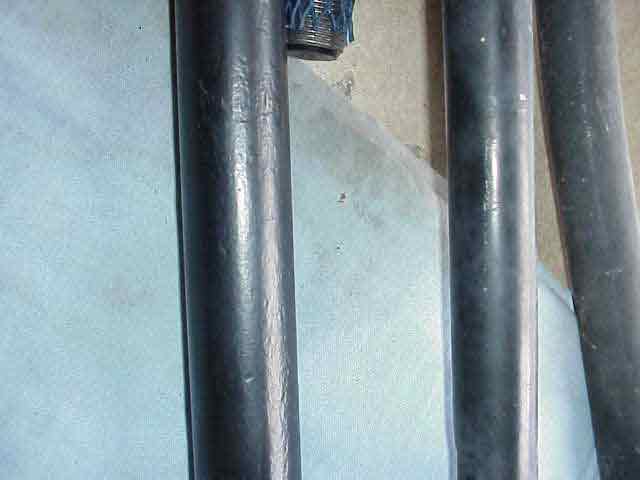
Note: Here is some additional information from Frank, an east-coast wheelin’ buddy of mine:
McMaster-Car sells a flush style grease fitting that I believe will solve the clearance issue some have with the Currie HD Steering System. When installed only the Hex head of the fitting is sticking out by about 1/8″. Here is the info.
The McM-Car Part Number = 10595K14
Description = 1/4″-28 Flush Style Grease Fitting
Print catalog page # = 1,984
Cost = $4.55 for a package of 5
Hope some find this useful.
Frank
I thought I would toss this picture in just to give you a comparison of the old and new hardware. This is a picture of the drag link sections. The Currie drag link is on the left. You can see the that the Currie is certainly beefier than the factory setup. I measured the tie rods too…the Currie was 1.25″ and the factory was .875″….the Currie is solid rod and the factory tie rod is the rather thin walled tubing. I do not expect any problems from this new Currie setup.
Currie Heavy Duty Steering
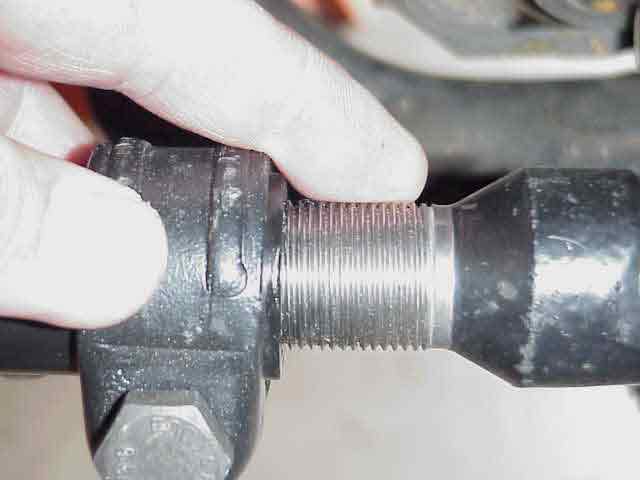
Here is the business end of the driver’s side rod end. There is no way to describe this other than it is built big and tough. The threads measured .85″ in diameter.
So, all three rod ends were connected and the castle nuts torqued to 55 ft. lbs, per the install instructions supplied by Currie. Cotter pins were inserted into the castle nuts and we were two thirds of the way through our project. Next was the toe alignment.
I had not done my own toe-in adjustment before this project but I could see no reason not to learn how to do it. During my last front end alignment, a local Jeeper, FlexyXJ, let me come into the back of the shop and watch has he did mine (in fact, he put my ZJ tie rod on at the same time I was getting my alignment done). He didn’t use the fancy laser and computer setup like so many shops use these days….he prefers the old fashioned method and I liked the results.
We put the tires back on and I torqued the lug nuts to 100 ft. lbs. The tires, prior to our making any adjustments, looked as though they were pointing in two different directions. Before we got down to making any accurate measurements, we needed to get them both pointing toward the front of the vehicle. With the clamps still loose, we turned the tie-rod and brought the tires more towards the front of the vehicle. We also turned on the adjusting sleeve on the drag link (near the pitman arm), with the steering wheel near its center of travel, to further get the tires and wheels into a more correct relationship with each other. OK….things were looking a bit better now.
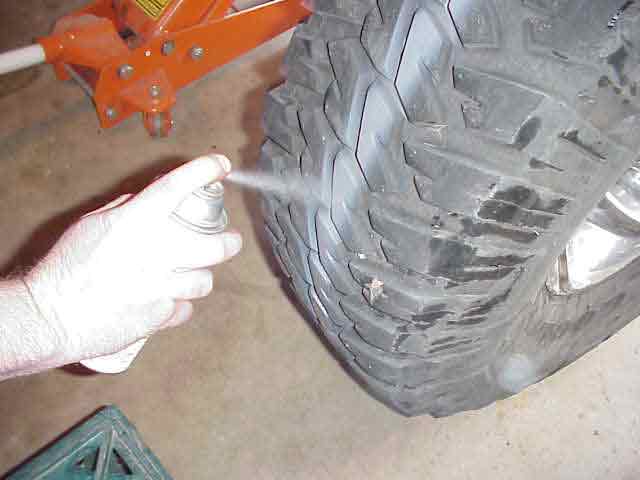
With axle supported just enough to allow the wheels to freely spin, Scott spun the tire while I painted a striped down the tire using some grey primer. We needed to lay down a clealry visible background for our measurements that we were about ready to start.
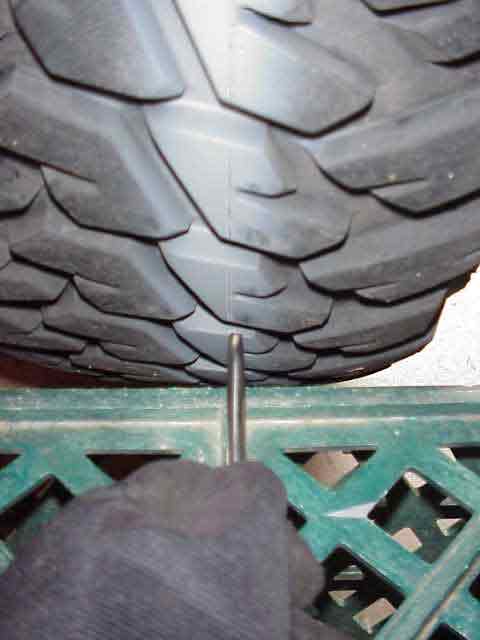
I slid a milk crate up to the tire and grabbed a Phillips screw driver (with a good pointy tip). As Scott continued to spin the tire, I carefully scribed a line on the freshly painted tire. You can see it in the picture. Note that you can NOT move the screw drier (or what ever you decide to use) while doing this. The key is that you will have a line on the tire that runs perfectly around the tire in a straight line. This is done on both tires. The result will be a thin fine line on each tire that we will then use as our measuring points.
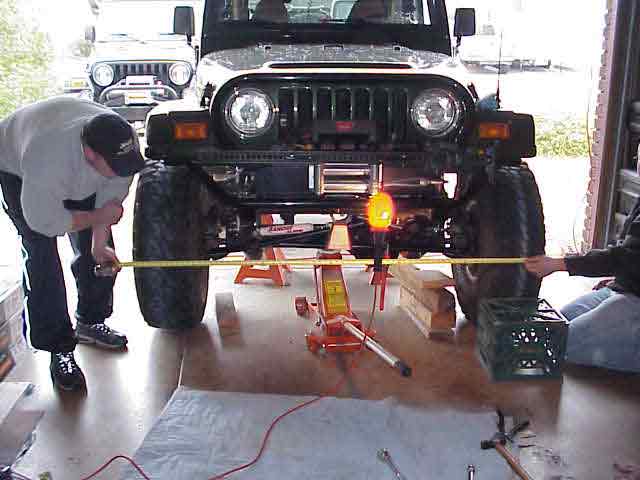
Select a point half way up the height of the tire (on both sides) and measure the distance between the lines at that spot. Note the exact measurement as accurately as you can (yes, 1/32 of an inch will make a difference here). Now, move the tape measure to the back side of the tires. Again, select a point half way up the height of the tire and take your measure, just as you did on the front side. For a 35″ tire, the correct toe-in measurement will have your the front and rear measurements differing by slightly more than 1/8″ (with the front measurement being the smaller of the two). I guess I should say that this is MY correct toe-in measurement. You can obviously set yours up for what ever you want. Some folks like no toe-in at all. (I tried this and found that my TJ wanders just a bit on the highway when set up this way.)
It makes no difference what the actual measurements are but only that they differ by approximately 1/8″ (I call it “fat” eight inch…again, these are MY measurements). Continue to turn (adjust) the tie-rod until you obtain the desired toe in. Now tighten the clamps at each end of the tie rod. We found we had to “tweak” our tie rod rotation ever so slightly so that the passenger side clamp would properly clear the nearby brackets on the axle. The Currie instructions mention that you should check this and you want to be sure that you won’t have hardware mashing into each other when your suspension cycles while your wheels are turned side to side. Take your time while you do the toe-in and get it right.
Currie Heavy Duty Steering
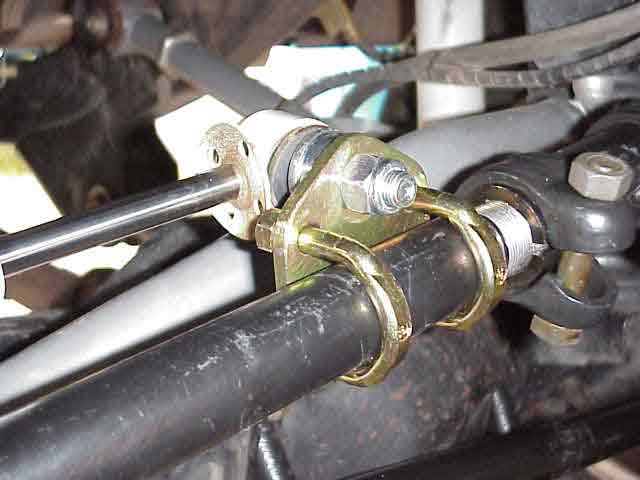
Once you have your toe-in set to the desired amount, you can attach the steering stabilizer to the drag link. Bolt the stabilizer to the bracket and loosely attached the bracket to the drag link. With your steering wheel turned as far to the right as possible, adjust the stabilizer so that a 1/4″ of the shaft is exposed. Tighten the bracket u-bolts.
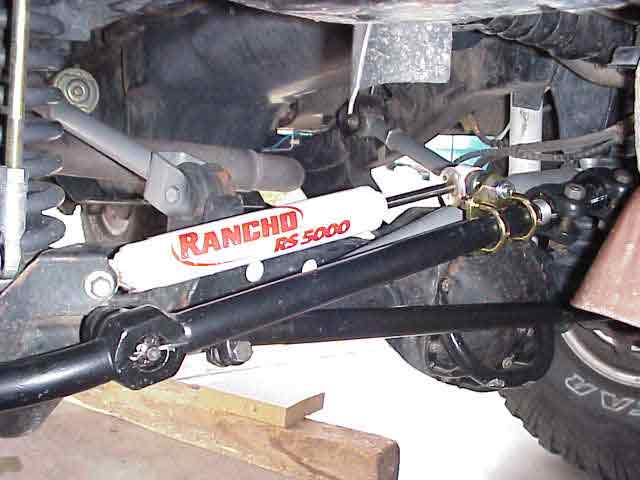
Turn the steering wheel to the far left (you should be on the right knuckle’s steering stop) and note that there is no binding and that the stabilizer does not max out before you get to the steering stop. If it does, you will need a different stabilizer. I am using the Rancho RS-5000 OEM replacement and it had no problem going lock to lock.
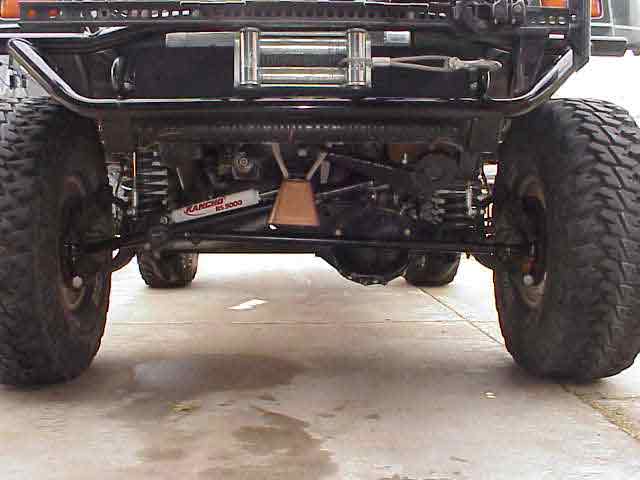
The last thing you need to do is center your steering wheel with your wheels pointing straight ahead. This is done by turning the adjuster by the pitman arm. We removed the jack stands and the wood blocks and put the tires back on the ground with the tires pointing straight ahead (well, OK….as straight as we could make them). Les watched the steering wheel as I turned the adjuster. Slowly, the steering wheel came to the center position. I took it for a short test drive and found that the wheel was just slightly off to the right. Back in the driveway, I again turned the adjuster until the wheel was centered. You might have to do this a couple of times….adjustment, test drive, adjustment, test drive….until the Jeep is going nice and straight and your wheel is properly centered.
I tightened the clamps on the drag link adjuster, filled the remaining three fittings with grease, and called the project a success! Many thanks to Scott and Les for their help. I know that Scott’s toes were getting cold (he kept reminding us of that) but I am not sure why that was happening. Granted, it was the coldest day we had seen this winter (yeah, there was even some frost on the lawn this morning) and the humidity was up from last nights rain shower. With Christmas just a few days away, I feel like I got to cheat and opened one of my presents early.
On a side note, I am thinking that Les might be doing this upgrade in a little bit. He is running the factory tie-rod and 35″ tires. We noticed this morning that he had sold his aluminum wheels and put black rock crawlers on his TJ. He admitted that he was expecting his wheels to be taking more of a beating in the future….so yeah, I think it is time for him to get his steering up to speed for the harder trails.
Once I get some road and trail time on the Currie hardware, I’ll do an update here and let you know what I think about it. Given that it is s Currie product, I don’t expect anything but good performance.
Remember…..TREADLightly!
